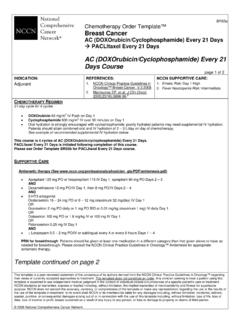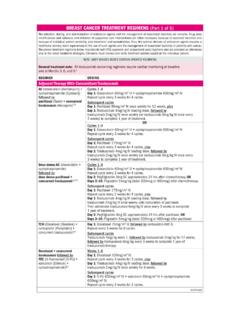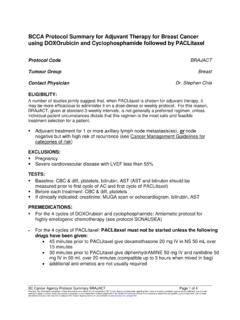Transcription of ANNEX I SUMMARY OF PRODUCT CHARACTERISTICS
1 1 ANNEX I SUMMARY OF PRODUCT CHARACTERISTICS 2 1. NAME OF THE MEDICINAL PRODUCT Herceptin 150 mg powder for concentrate for solution for infusion 2. QUALITATIVE AND QUANTITATIVE COMPOSITION One vial contains 150 mg of trastuzumab, a humanised IgG1 monoclonal antibody produced by mammalian (Chinese hamster ovary) cell suspension culture and purified by affinity and ion exchange chromatography including specific viral inactivation and removal procedures. The reconstituted Herceptin solution contains 21 mg/mL of trastuzumab. For the full list of excipients, see section 3. PHARMACEUTICAL FORM Powder for concentrate for solution for infusion. White to pale yellow lyophilised powder. 4. CLINICAL PARTICULARS Therapeutic indications Breast cancer Metastatic breast cancer Herceptin is indicated for the treatment of adult patients with HER2 positive metastatic breast cancer: (MBC): - as monotherapy for the treatment of those patients who have received at least two chemotherapy regimens for their metastatic disease.
2 Prior chemotherapy must have included at least an anthracycline and a taxane unless patients are unsuitable for these treatments. Hormone receptor positive patients must also have failed hormonal therapy, unless patients are unsuitable for these treatments. - in combination with paclitaxel for the treatment of those patients who have not received chemotherapy for their metastatic disease and for whom an anthracycline is not suitable. - in combination with docetaxel for the treatment of those patients who have not received chemotherapy for their metastatic disease. - in combination with an aromatase inhibitor for the treatment of postmenopausal patients with hormone-receptor positive MBC, not previously treated with trastuzumab.
3 Early breast cancer Herceptin is indicated for the treatment of adult patients with HER2 positive early breast cancer. (EBC). - following surgery, chemotherapy (neoadjuvant or adjuvant) and radiotherapy (if applicable) (see section ). 3 - following adjuvant chemotherapy with doxorubicin and cyclophosphamide, in combination with paclitaxel or docetaxel. - in combination with adjuvant chemotherapy consisting of docetaxel and carboplatin. - in combination with neoadjuvant chemotherapy followed by adjuvant Herceptin therapy, for locally advanced (including inflammatory) disease or tumours > 2 cm in diameter (see sections and ). Herceptin should only be used in patients with metastatic or early breast cancer whose tumours have either HER2 overexpression or HER2 gene amplification as determined by an accurate and validated assay (see sections and ).
4 Metastatic gastric cancer Herceptin in combination with capecitabine or 5-fluorouracil and cisplatin is indicated for the treatment of adult patients with HER2 positive metastatic adenocarcinoma of the stomach or gastro-esophageal junction who have not received prior anti-cancer treatment for their metastatic disease. Herceptin should only be used in patients with metastatic gastric cancer (MGC) whose tumours have HER2 overexpression as defined by IHC2+ and a confirmatory SISH or FISH result, or by an IHC 3+ result. Accurate and validated assay methods should be used (see sections and ). Posology and method of administration HER2 testing is mandatory prior to initiation of therapy (see sections and ). Herceptin treatment should only be initiated by a physician experienced in the administration of cytotoxic chemotherapy (see section ), and should be administered by a healthcare professional only.
5 It is important to check the PRODUCT labels to ensure that the correct formulation (intravenous or subcutaneous fixed dose) is being administered to the patient, as prescribed. Herceptin intravenous formulation is not intended for subcutaneous administration and should be administered via an intravenous infusion only. Switching treatment between Herceptin intravenous and Herceptin subcutaneous formulations and vice versa, using the three-weekly (q3w) dosing regimen, was investigated in study MO22982 (see section ). In order to prevent medication errors it is important to check the vial labels to ensure that the drug being prepared and administered is Herceptin (trastuzumab) and not Kadcyla (trastuzumab emtansine). Posology Metastatic breast cancer Three-weekly schedule The recommended initial loading dose is 8 mg/kg body weight.
6 The recommended maintenance dose at three-weekly intervals is 6 mg/kg body weight, beginning three weeks after the loading dose. Weekly schedule The recommended initial loading dose of Herceptin is 4 mg/kg body weight. The recommended weekly maintenance dose of Herceptin is 2 mg/kg body weight, beginning one week after the loading dose. 4 Administration in combination with paclitaxel or docetaxel In the pivotal trials (H0648g, M77001), paclitaxel or docetaxel was administered the day following the first dose of Herceptin (for dose, see the SUMMARY of PRODUCT CHARACTERISTICS (SmPC) for paclitaxel or docetaxel) and immediately after the subsequent doses of Herceptin if the preceding dose of Herceptin was well tolerated. Administration in combination with an aromatase inhibitor In the pivotal trial (BO16216) Herceptin and anastrozole were administered from day 1.
7 There were no restrictions on the relative timing of Herceptin and anastrozole at administration (for dose, see the SmPC for anastrozole or other aromatase inhibitors). Early breast cancer Three-weekly and weekly schedule As a three-weekly regimen the recommended initial loading dose of Herceptin is 8 mg/kg body weight. The recommended maintenance dose of Herceptin at three-weekly intervals is 6 mg/kg body weight, beginning three weeks after the loading dose. As a weekly regimen (initial loading dose of 4 mg/kg followed by 2 mg/kg every week) concomitantly with paclitaxel following chemotherapy with doxorubicin and cyclophosphamide. See section for chemotherapy combination dosing. Metastatic gastric cancer Three-weekly schedule The recommended initial loading dose is 8 mg/kg body weight.
8 The recommended maintenance dose at three-weekly intervals is 6 mg/kg body weight, beginning three weeks after the loading dose. Breast cancer and gastric cancer Duration of treatment Patients with MBC or MGC should be treated with Herceptin until progression of disease. Patients with EBC should be treated with Herceptin for 1 year or until disease recurrence, whichever occurs first; extending treatment in EBC beyond one year is not recommended (see section ). Dose reduction No reductions in the dose of Herceptin were made during clinical trials. Patients may continue therapy during periods of reversible, chemotherapy-induced myelosuppression but they should be monitored carefully for complications of neutropenia during this time.
9 Refer to the SmPC for paclitaxel, docetaxel or aromatase inhibitor for information on dose reduction or delays. If left ventricular ejection fraction (LVEF) percentage drops 10 points from baseline AND to below 50 %, treatment should be suspended and a repeat LVEF assessment performed within approximately 3 weeks. If LVEF has not improved, or has declined further, or if symptomatic congestive heart failure (CHF) has developed, discontinuation of Herceptin should be strongly considered, unless the benefits for the individual patient are deemed to outweigh the risks. All such patients should be referred for assessment by a cardiologist and followed up. 5 Missed doses If the patient has missed a dose of Herceptin by one week or less, then the usual maintenance dose (weekly regimen: 2 mg/kg; three-weekly regimen: 6 mg/kg) should be administered as soon as possible.
10 Do not wait until the next planned cycle. Subsequent maintenance doses should be administered 7 days or 21 days later according to the weekly or three-weekly schedules, respectively. If the patient has missed a dose of Herceptin by more than one week, a re-loading dose of Herceptin should be administered over approximately 90 minutes (weekly regimen: 4 mg/kg; three-weekly regimen: 8 mg/kg) as soon as possible. Subsequent Herceptin maintenance doses (weekly regimen: 2 mg/kg; three-weekly regimen 6 mg/kg respectively) should be administered 7 days or 21 days later according to the weekly or three-weekly schedules respectively. Special populations Dedicated pharmacokinetic studies in the elderly and those with renal or hepatic impairment have not been carried out.














